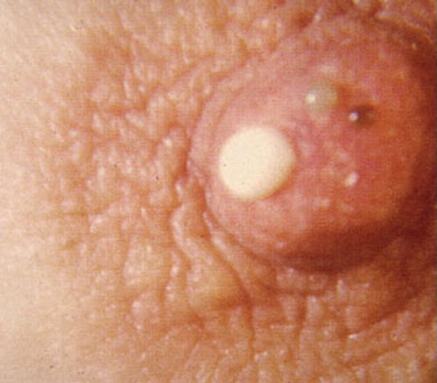Table of Contents
Overview – Nipple Obstructions
Nipple obstructions refer to conditions that block the flow through the nipple’s lactiferous ducts, often leading to cyst formation, inflammation, or discharge. The most common causes include duct ectasia and galactocoele. These conditions typically affect women during or after their reproductive years and can clinically mimic breast malignancy, making accurate diagnosis essential.
Definition
Nipple obstructions occur when one or more ducts leading to the nipple become blocked, causing secretory build-up and secondary inflammatory or cystic changes.
Duct Ectasia
Aetiology
- Obstruction of nipple outflow ducts
Pathogenesis
- Stagnation of breast secretions due to duct obstruction
→ Inflammatory response
→ Fibrosis in the healing phase
→ Possible nipple inversion, mimicking malignancy - Analogy: Pathogenesis resembles “cystic acne” of the nipple
Morphology
- Dilated (ectatic) lactiferous ducts
- Accumulated debris and secretions
- Possible inflammatory infiltrates and fibrotic changes
Clinical Features
- Typically affects multiparous women aged 40–60
- Symptoms:
- Poorly defined periareolar mass
- Nipple discharge (serous, purulent, or bloody)
- Nipple retraction or inversion (if fibrosis develops)
- Pain is uncommon
- Important clinical mimic of breast carcinoma:
- Firm, irregular mass may be indistinguishable from invasive cancer on palpation or mammogram
Management
- Diagnosis:
- Imaging and fine needle aspiration (FNA)
- Rule out differential diagnoses like intraductal papilloma
- Treatment:
- Often self-limiting
- Antibiotics may help if secondary infection suspected
- Surgical duct excision only if persistent or recurrent


Galactocoele
Aetiology
- Obstruction of a ductal outlet by proteinaceous material
Pathogenesis
- Protein plug blocks duct
→ Accumulation of sterile milk
→ Formation of a cystic mass
Morphology
- Macroscopic:
- Smooth, malleable, fluid-filled mass
- Microscopic:
- Large cyst lined by normal duct epithelium
- Filled with milk proteins
Clinical Features
- Common during or shortly after lactation
- Presents as a non-tender, centrally located breast lump
- Not associated with infection
- Drainage usually ineffective:
- Milk reaccumulates due to persistent obstruction
- Self-limiting once breastfeeding ceases
Management
- No intervention usually required
- Resolves after cessation of lactation
- Drainage is not effective and recurrence is common during ongoing lactation
Summary – Nipple Obstructions
Nipple obstructions, including duct ectasia and galactocoele, commonly affect lactating or perimenopausal women. Duct ectasia can mimic breast cancer due to fibrosis and mass formation, while galactocoeles are benign milk-filled cysts that resolve post-lactation. Careful history, imaging, and biopsy help distinguish these from malignant lesions. For a broader context, see our Reproductive Health Overview page.